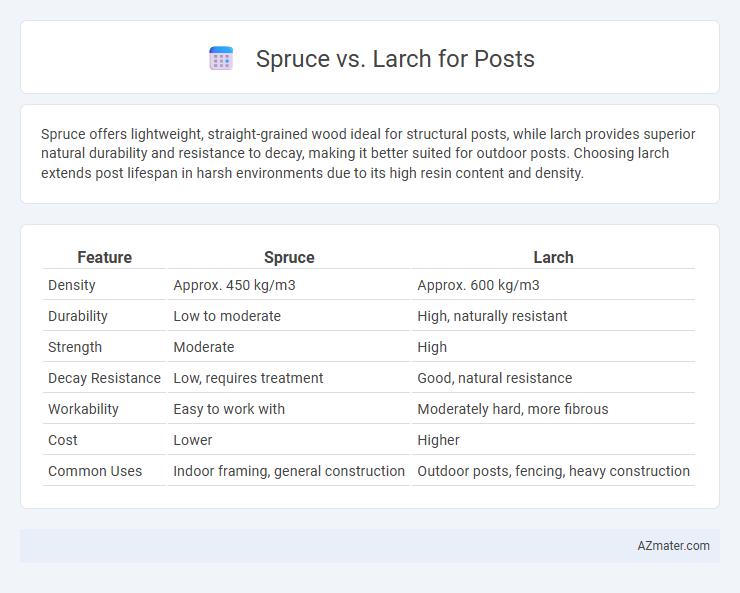Spruce offers lightweight, straight-grained wood ideal for structural posts, while larch provides superior natural durability and resistance to decay, making it better suited for outdoor posts. Choosing larch extends post lifespan in harsh environments due to its high resin content and density.
Table of Comparison
| Feature | Spruce | Larch |
|---|---|---|
| Density | Approx. 450 kg/m3 | Approx. 600 kg/m3 |
| Durability | Low to moderate | High, naturally resistant |
| Strength | Moderate | High |
| Decay Resistance | Low, requires treatment | Good, natural resistance |
| Workability | Easy to work with | Moderately hard, more fibrous |
| Cost | Lower | Higher |
| Common Uses | Indoor framing, general construction | Outdoor posts, fencing, heavy construction |
Introduction to Spruce and Larch for Posts
Spruce and larch are popular choices for posts due to their strength and durability in outdoor applications. Spruce offers a lightweight yet strong wood with good resistance to bending, making it ideal for supporting structures. Larch provides exceptional natural decay resistance and density, enhancing the lifespan of posts exposed to moisture and harsh weather conditions.
Botanical Characteristics: Spruce vs Larch
Spruce (genus Picea) is an evergreen conifer with needle-like leaves attached singly to branches, characterized by sharp, stiff needles and cones that hang downward. Larch (genus Larix) is a deciduous conifer, notable for its soft, clustered needles that turn yellow and shed in autumn, with upright cones on the branches. Both species differ in their needle arrangement, retention, and cone orientation, influencing their durability and aesthetic appeal in post applications.
Strength and Durability Comparison
Spruce offers moderate strength with a lightweight structure, making it suitable for posts in low to medium load applications, while larch provides superior strength and natural durability, ideal for outdoor posts exposed to harsh weather. Larch's high resin content enhances its resistance to decay and insect damage, ensuring longer-lasting performance compared to spruce. For structural posts requiring longevity and robustness, larch is the preferred choice due to its combination of toughness and natural resilience.
Natural Rot Resistance
Larch wood exhibits superior natural rot resistance compared to spruce, making it a preferred choice for outdoor posts exposed to moisture. The high resin content and dense grain of larch contribute to its durability and longevity in damp conditions, while spruce tends to be more susceptible to decay and fungal attack. For posts requiring long-term structural integrity without chemical treatment, larch offers a more reliable and sustainable option.
Moisture Tolerance and Weathering
Spruce posts exhibit moderate moisture tolerance but tend to absorb water, leading to potential warping and decay if not properly treated. Larch posts have superior natural moisture resistance due to high resin content, making them more durable in wet and variable weather conditions. This inherent weathering resilience allows larch to maintain structural integrity longer than spruce in outdoor applications.
Workability and Ease of Installation
Spruce offers superior workability due to its uniform grain and lightweight nature, making it easier to saw, nail, and drill during post installation. Larch, while denser and harder, provides excellent durability but requires more effort and specialized tools for cutting and fastening. Choosing spruce enhances efficiency and reduces labor time, whereas larch demands careful handling to avoid splitting and ensure precise fitting.
Cost and Availability
Spruce posts are generally more affordable and widely available due to their fast growth and abundant supply in North America. Larch posts tend to be more expensive because of their slower growth rate and limited regional availability, particularly in Europe and parts of Russia. Cost-conscious projects often favor spruce for budget efficiency and easy sourcing, while larch is chosen for its durability despite higher costs.
Environmental Impact and Sustainability
Spruce and larch both serve as popular timber choices for posts, but larch offers higher natural durability, reducing the need for chemical treatments and minimizing environmental impact. Spruce, while less durable, is generally faster-growing and more widely available, which can promote sustainability through efficient forest management and replanting practices. Sustainable sourcing certifications such as FSC or PEFC enhance the eco-friendly credentials of both woods, supporting responsible forestry and reducing carbon footprint in post production.
Common Uses in Construction and Landscaping
Spruce is commonly used for structural framing, interior paneling, and fencing due to its lightweight, straight grain, and ease of handling, making it ideal for construction projects requiring strength and stability. Larch is valued in landscaping and exterior applications like decking, fences, and posts because of its natural water resistance, durability, and attractive reddish hue, ensuring longevity in outdoor environments. Both woods are popular for posts, but spruce is preferred for indoor structural use, while larch excels in outdoor posts subject to moisture and weather exposure.
Choosing the Right Wood: Spruce or Larch?
Spruce offers a lightweight, cost-effective option with moderate durability ideal for indoor posts, while larch provides superior resistance to decay and moisture, making it optimal for outdoor or ground-contact posts. Larch's dense grain structure enhances weather resistance and longevity, outweighing its higher price compared to spruce. Selecting between spruce and larch depends on environmental exposure, budget, and required durability for post applications.

Infographic: Spruce vs Larch for Post
 azmater.com
azmater.com